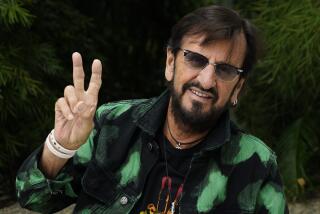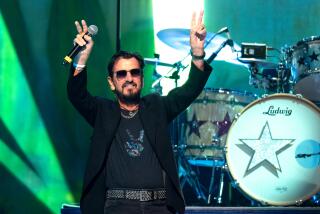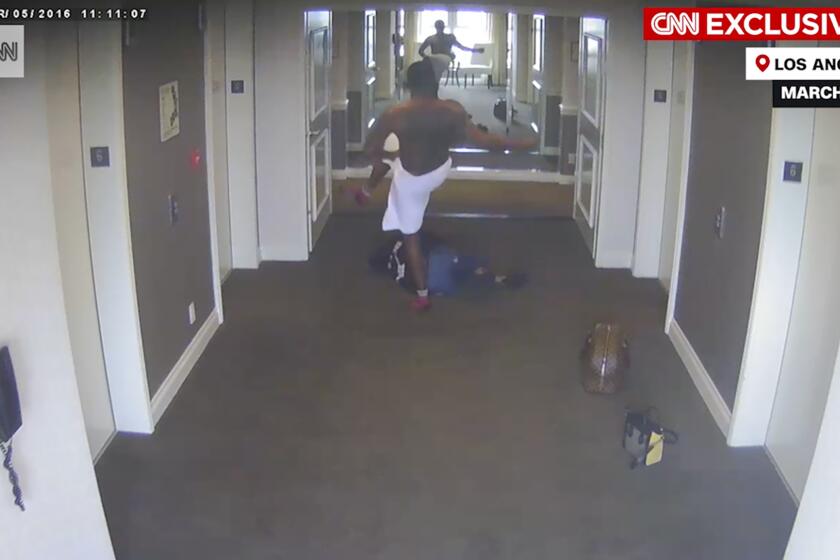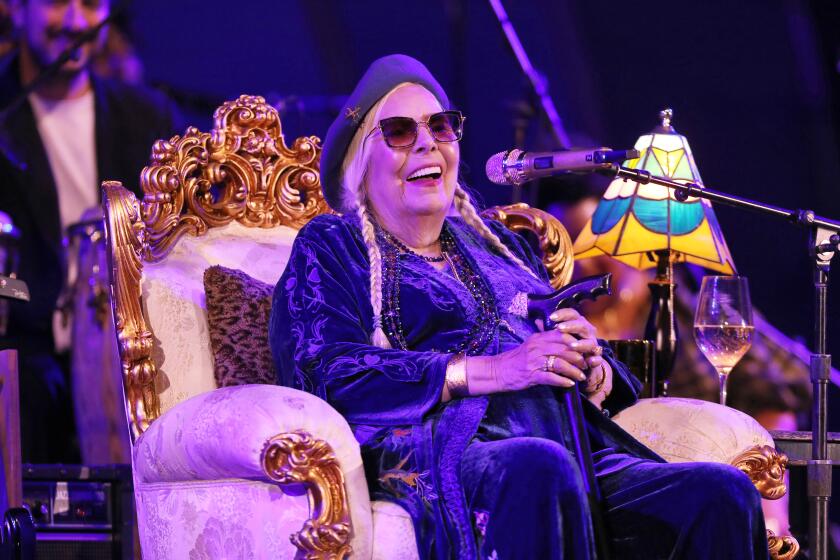Love you, yeah yeah yeah
It was 40 years ago next week that the Beatles taught their fans to shriek -- here in the United States, that is.
In a watershed moment in cultural history, 73 million viewers tuned in to CBSâ âThe Ed Sullivan Showâ on Feb. 9, 1964 to meet John, Paul, George and Ringo.
Fans in England and much of Europe had been bonkers for the group for more than a year, but U.S. record executives were dubious that the new British bands would catch on here. An infamous Capitol Records memo from 1963 said the Beatlesâ music âwasnât suitable for the American market.â
Now, of course, itâs widely accepted that in the wake of John F. Kennedyâs assassination on Nov. 22, 1963, in Dallas, the Beatles brought a desperately needed infusion of optimism to a psychically wounded nation.
A raft of new books, DVDs and special events celebrates the groupâs arrival in the the United States, but ongoing interest in the Beatles goes beyond nostalgia. Capitol Records reports that buyers 30 and younger were responsible for 42.5% of sales of the Beatles â1â hits compilation, which has sold 9.2 million copies since its release in 2000.
In honor of the 20 No. 1 Beatles singles that started that long-ago winter, here are 20 facts about their arrival in the U.S. that, depending on your age, youâve forgotten, never heard back then or canât possibly recall because you werenât born yet.
(1) CBS News had prepared a piece on the Beatles almost three months before the groupâs Sullivan show debut. It ran as scheduled on the networkâs morning newscast of Nov. 22, 1963, two hours before Kennedy was shot. Because of assassination coverage, the Beatles story was shelved and didnât air on the more widely viewed âCBS Evening Newsâ until Dec. 10, when anchor Walter Cronkite felt a nation in mourning might be ready for something uplifting.
(2) One viewer that night was Maryland teenager Marsha Albert. She wrote to a DJ at her local radio station in Washington, D.C., asking that he play some Beatles music. The station, WWDC, got a copy of âI Want to Hold Your Handâ from England and played it exclusively for several days, igniting in fans the fire that would result in Capitol Recordsâ rush-releasing it here. That led stations in other major cities to jump on the record, prompting thousands of screaming teens to greet the four musicians when they arrived in New York on Feb. 7. Beatles historian Bruce Spizer credits Albert for playing a pivotal role in the start of U.S. Beatlemania.
(3) The group needed that kick-start because three singles had flopped before âI Want to Hold Your Hand.â Because Capitol had rejected the group, the early singles were released by small, independent labels. Until December 1963, the group still had no U.S. record contract.
(4) Vee-Jay Records, the Chicago-based gospel and R&B; label, released two Beatles records in â63, also landing the right of first refusal on future Beatles singles in the U.S. The label lost the inside track when it couldnât come up with $859 in royalty payments it owed EMI Records, the Beatlesâ U.K. record company.
(5) Brian Epstein, the manager of a band that was a failure at that point in the U.S., somehow persuaded Sullivan in early November â63 to commit to what became three consecutive appearances and to give the group headliner status. Originally Sullivan had considered the Beatles a novelty act and envisioned them performing one number on a couple of shows.
(6) With the Sullivan appearances booked, Epstein phoned Capitol President Alan Livingston directly and persuaded him to sign the band despite the labelâs four previous rejections.
(7) The day before the first Sullivan performance, George Harrison came down with strep throat and a 104-degree fever, causing him to miss the camera rehearsal as well as a group photo shoot in Central Park.
(8) The song list for the first Sullivan show, in order: âAll My Loving,â âTill There Was You,â âShe Loves You,â âI Saw Her Standing Thereâ and âI Want to Hold Your Hand.â Over the course of four Sullivan appearances, the Beatles played 20 songs in all.
(9) After the first three Sullivan shows, all of the pre-âI Want To Hold Your Handâ singles became hits upon being re-released. The most popular, âShe Loves You,â went to No. 1.
(10) On April 4, 1964, the Beatles held the top five slots on Billboardâs Hot 100 singles chart -- an unprecedented feat then that no act has repeated.
(11) The least successful of 30 records the group placed in Billboardâs Top 100 in 1964 alone was âSie Liebt Dich,â the German-language version of âShe Loves You,â which peaked at No. 97.
(12) Former Beatles drummer Pete Best, who had been fired in August 1962 and replaced by Ringo Starr, got his shot on American TV in March 1964 -- as a guest on the game show âIâve Got a Secret.â
(13) The now-classic black-and-white photo for the cover of the âMeet the Beatlesâ album was shot by Robert Freeman at a Bournemouth, England, hotel where the group was staying. âI was originally offered the equivalent of $50 for the cover,â Freeman writes in his book, âThe Beatles: A Private View.â âHowever, [Epstein] did support me in persuading EMI to pay double their normal fee -- $100.â
(14) The bandâs first full-scale U.S. tour opened Aug. 19 at the Cow Palace in San Francisco and included 32 shows in 23 cities. Support acts were the Righteous Brothers, Jackie DeShannon and the Bill Black Combo.
(15) Kansas City, Mo., was not originally on the â64 tour itinerary, but Kansas City Athletics owner Charlie Finley wanted the Beatles to play his town. Epstein turned him down repeatedly as Finley kept upping his offer. Epstein accepted when that offer hit $150,000, at the time the highest amount ever paid an entertainer for one show.
(16) After their Aug. 23 Hollywood Bowl concert, Lennon, Harrison and Starr decided to chance a night out, away from Epstein and their entourage. They headed to the Whisky A Go-Go to see Johnny Rivers. Lennonâs date for the evening: actress Jayne Mansfield.
(17) Before a Sept. 11, 1964, concert at the Gator Bowl in Jacksonville, Fla., a local promoter reportedly said seating would be segregated by race. McCartney went on record saying the Beatles would never play to a segregated crowd. When the band arrived, they found a fully integrated audience.
(18) Only two things were powerful enough to slow Beatlemania in 1964: a president and a hurricane. The groupâs plane was delayed from landing in Jacksonville because Air Force One was about to touch down with President Johnson to tour the area recently hammered by Hurricane Dora.
(19) Back in New York City at the end of the first tour, the band got a visit from Bob Dylan, who reportedly introduced them to marijuana that evening. âWe had a crazy party the night we met,â McCartney told journalist Larry Kane. âI thought I got the meaning to life that night.â
(20) Psychic Jeanne Dixon, who became a celebrity for predicting Kennedyâs assassination, set the Beatlesâ nerves on edge for saying the groupâs plane would crash on its flight out of Philadelphia. That trip was uneventful, but on their 1965 U.S. tour one engine of their private plane caught fire during a flight from Minneapolis to Portland, Ore. The plane landed safely but was replaced the next day.
*
(Begin Text of Infobox)
Unabated Beatlemania
The 40th anniversary of the Beatlesâ 1964 arrival in the United States is going anything but unnoticed:
* IN PRINT: Beatles historian Bruce Spizerâs âThe Beatles Are Coming! The Birth of Beatlemania in Americaâ; broadcast journalist Larry Kaneâs âTicket to Ride,â chronicling his travels with the group on its 1964 and 1965 U.S. concert tours; veteran Beatles photographer Robert Freemanâs âThe Beatles: A Private View.â
* ON DVD: âThe Four Complete Ed Sullivan Shows Featuring the Beatlesâ; âThe Beatles: The First U.S. Visit,â an expanded two-disc version of Albert and David Mayslesâ 1964 film documentary capturing the early days of Beatlemania and said to be the blueprint for âA Hard Dayâs Night.â
* ON TV: Most networks and cable news channels will devote pieces to the Beatles. And the Feb. 8 Grammy Awards broadcast on CBS will salute the impact of the groupâs first appearance on Sullivanâs show, which occurred on the same night, time and network exactly 40 years earlier.
* IN PERSON: The Museum of Television & Radio in Los Angeles and New York will host a three-month exhibition âThe Beatles in Americaâ opening Friday; a âFab Forty Beatles Gatheringâ will be held at the groupâs star on the Hollywood Walk of Fame on Feb. 7
* ONLINE: A website, www.thefab40.com, has been created to keep tabs on various products, events and activities related to the anniversary. Another, www.thebeatlesarecoming.com, references Spizerâs book with information from court records and record company documents relating to the groupâs launch in the U.S.
-- Randy Lewis
More to Read
The biggest entertainment stories
Get our big stories about Hollywood, film, television, music, arts, culture and more right in your inbox as soon as they publish.
You may occasionally receive promotional content from the Los Angeles Times.










